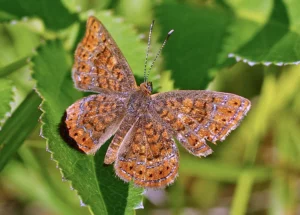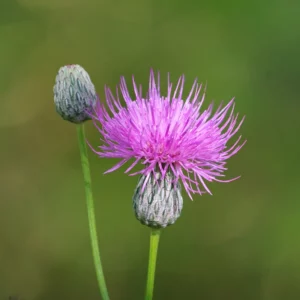Note: Most links leave to external sites.
Greetings, BugFans,
This is a slightly massaged episode that was originally posted in June of 2010.
Recently the BugLady was privileged to photograph this lovely butterfly at Riveredge Nature Center, one of its few known breeding areas in Wisconsin, (thanks, Mary). In 2010, Riveredge tallied a record number of Swamp Metalmarks (30) in their annual July Butterfly count (and the BugLady hopes the butterflies and their cryptic offspring were all accounted for after her size 12’s exited the area).
There are about 1000 Metalmark family members worldwide, and North America boasts almost all of them. The family is primarily tropical, and as Wagner says in Caterpillars of Eastern North America, “Not far into the Neotropics this subfamily[family] explodes into a boundless array of wondrous butterflies…they are a study in variation and complexity, both as larvae and adults.” The BugLady thinks there’s nothing shabby about the Swamp Metalmark, either.
This little beauty is little – its less-than-an-inch-wide-wingspan is described by Wagner as “dime-size.” The top surface of its wings is brownish orange, the underside is orangey, and its name comes from the rows of silvery markings on its wings. The front wings of males are more pointed than are the females’ wings, and while females have six full-length legs, males’ front legs are reduced.
Despite its name, the Swamp metalmark prefers not swamps (wooded wetlands), but open spaces that are soggy underfoot (“Fen Metalmark” would be a better name). So, if you spot a dark brown/orange, tiny, moth-like butterfly that flies slowly, below knee-level, through alkaline fens with hummocky sedges and low vegetation, and then hides under leaves, it’s worth a second look.
Everyone agrees that Swamp Metalmark populations are in trouble, and the species is listed as rare/endangered in the areas where it is known to live (it is among the first insects whose status earned it a spot on the Wisconsin Endangered and Threatened Species List in 1989).
What is interesting about the Swamp Metalmark is that we can’t accurately chart how abundant it has ever been. There are three species of metalmarks – the Little, the Swamp, and the Northern – that divide the eastern half of the country by habitat. The Little Metalmark and the Northern Metalmark are long-standing species described by the mid-1800’s, but the Swamp Metalmark was not recognized as a species until 1937, when it was split off from the Northern Metalmark. So, Swamp Metalmarks were being recorded, but as something else (and sometimes, even as a western species with the awesome name of the Fatal Metalmark). Their total range is limited to just a few areas in the Midwest (Missouri is considered the historic heart of its range), and it is assumed that many of its former locations are now empty of the species. Small colonies of Swamp Metalmarks exist in only two counties in Wisconsin.
Its life history seems like an invitation to extinction. Its habitat needs are very specific (location, location, location); its caterpillar eats the leaves of a single, uncommon species of thistle; the adults’ nectar on only a half-dozen or so flowers; they don’t fly very high, and they don’t stray very far from their never-common-and-increasingly-rare habitat. Lethargic species occupying small areas can get in trouble pretty fast because of increasingly low genetic diversity. Their habitat is under attack by the normal succession of plant communities and by invasive alien woody plants. Since the caterpillars are vulnerable to fire, the kinds of burns normally used to maintain habitat can’t be used.
Eggs are laid only on the undersides of the downy, basal rosette of the swamp thistle (it’s a biennial, and its first-year leaves lie close on the ground). The resulting caterpillars hatch, feed briefly, and hibernate under those same basal leaves, lying along the leaves’ mid-rib. The caterpillars are described as “slug-like” and covered with long hairs (Wagner offers the tantalizing tidbit that caterpillars are often attended by ants). In spring they resume eating, are ready to pupate in leaf litter by late June/early July and to fly (briefly) shortly afterwards. As adults, they nectar on swamp milkweed, swamp thistle, and shrubby cinquefoil, and on a few prairie plants like Black-eyed Susan, mountain mint, meadowsweet, and yarrow.
2023 update: For years, Riveredge Nature Center, in partnership with the Milwaukee Public Museum, took a leadership role in strengthening its metalmark population by increasing suitable habitat, salting other potential metalmark sites on the property with imported caterpillars, and studying habitat parameters. Riveredge Habitat Healers also managed habitat at the site of a small population in a neighboring county. Sadly, no Swamp Metalmarks have been counted at Riveredge during the past seven-plus butterfly counts.
On a different note: National Invasive Species Awareness Week (NISAW) is February 20 – 26, 2023. Whether they become invasive or not (most don’t, but some very dramatically do), non-native plants and animals compete with native species and lower biodiversity, and invasive species threaten the environment and the economy. Educate yourself and then educate your legislators, Parks and Rec people, etc.
The BugLady

